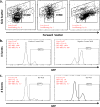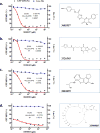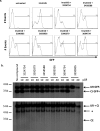High-Throughput Screening Approach for Identifying Compounds That Inhibit Nonhomologous End Joining
- PMID: 29232168
- PMCID: PMC5997544
- DOI: 10.1177/2472555217746324
High-Throughput Screening Approach for Identifying Compounds That Inhibit Nonhomologous End Joining
Abstract
DNA double-strand breaks (DSBs) are repaired primarily by homologous recombination (HR) or nonhomologous end joining (NHEJ). Compounds that modulate HR have shown promise as cancer therapeutics. The V(D)J recombination reaction, which assembles antigen receptor genes in lymphocytes, is initiated by the introduction of DNA DSBs at two recombining gene segments by the RAG endonuclease, followed by the NHEJ-mediated repair of these DSBs. Here, using HyperCyt automated flow cytometry, we develop a robust high-throughput screening (HTS) assay for NHEJ that utilizes engineered pre-B-cell lines where the V(D)J recombination reaction can be induced and monitored at a single-cell level. This approach, novel in processing four 384-well plates at a time in parallel, was used to screen the National Cancer Institute NeXT library to identify compounds that inhibit V(D)J recombination and NHEJ. Assessment of cell light scattering characteristics at the primary HTS stage (83,536 compounds) enabled elimination of 60% of apparent hits as false positives. Although all the active compounds that we identified had an inhibitory effect on RAG cleavage, we have established this as an approach that could identify compounds that inhibit RAG cleavage or NHEJ using new chemical libraries.
Keywords: cancer and cancer drugs; cell-based assays; immune system diseases; oncology.
Figures





Similar articles
-
Ku70 suppresses alternative end joining in G1-arrested progenitor B cells.Proc Natl Acad Sci U S A. 2021 May 25;118(21):e2103630118. doi: 10.1073/pnas.2103630118. Proc Natl Acad Sci U S A. 2021. PMID: 34006647 Free PMC article.
-
Generation and CRISPR/Cas9 editing of transformed progenitor B cells as a pseudo-physiological system to study DNA repair gene function in V(D)J recombination.J Immunol Methods. 2017 Dec;451:71-77. doi: 10.1016/j.jim.2017.08.007. Epub 2017 Sep 4. J Immunol Methods. 2017. PMID: 28882611 Free PMC article.
-
Functional redundancy between the XLF and DNA-PKcs DNA repair factors in V(D)J recombination and nonhomologous DNA end joining.Proc Natl Acad Sci U S A. 2013 Feb 5;110(6):2234-9. doi: 10.1073/pnas.1222573110. Epub 2013 Jan 23. Proc Natl Acad Sci U S A. 2013. PMID: 23345432 Free PMC article.
-
The response to and repair of RAG-mediated DNA double-strand breaks.Annu Rev Immunol. 2012;30:175-202. doi: 10.1146/annurev-immunol-030409-101320. Epub 2012 Jan 3. Annu Rev Immunol. 2012. PMID: 22224778 Free PMC article. Review.
-
Classical and alternative end-joining pathways for repair of lymphocyte-specific and general DNA double-strand breaks.Adv Immunol. 2012;116:1-49. doi: 10.1016/B978-0-12-394300-2.00001-6. Adv Immunol. 2012. PMID: 23063072 Review.
Cited by
-
Suppression of fumarate hydratase activity increases the efficacy of cisplatin-mediated chemotherapy in gastric cancer.Cell Death Dis. 2019 May 28;10(6):413. doi: 10.1038/s41419-019-1652-8. Cell Death Dis. 2019. Retraction in: Cell Death Dis. 2023 Jan 20;14(1):46. doi: 10.1038/s41419-023-05604-7. PMID: 31138787 Free PMC article. Retracted.
-
MYSM1 attenuates DNA damage signals triggered by physiologic and genotoxic DNA breaks.J Allergy Clin Immunol. 2024 Apr;153(4):1113-1124.e7. doi: 10.1016/j.jaci.2023.12.001. Epub 2023 Dec 6. J Allergy Clin Immunol. 2024. PMID: 38065233 Free PMC article.
-
Guidelines for the use of flow cytometry and cell sorting in immunological studies (second edition).Eur J Immunol. 2019 Oct;49(10):1457-1973. doi: 10.1002/eji.201970107. Eur J Immunol. 2019. PMID: 31633216 Free PMC article.
References
-
- Bryant HE, Schultz N, Thomas HD, et al. Specific killing of BRCA2-deficient tumours with inhibitors of poly(ADP-ribose) polymerase. Nature. 2005;434:913–917. - PubMed
-
- Farmer H, McCabe N, Lord CJ, et al. Targeting the DNA repair defect in BRCA mutant cells as a therapeutic strategy. Nature. 2005;434:917–921. - PubMed
Publication types
MeSH terms
Grants and funding
LinkOut - more resources
Full Text Sources
Other Literature Sources

